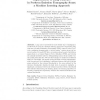Free Online Productivity Tools
i2Speak
i2Symbol
i2OCR
iTex2Img
iWeb2Print
iWeb2Shot
i2Type
iPdf2Split
iPdf2Merge
i2Bopomofo
i2Arabic
i2Style
i2Image
i2PDF
iLatex2Rtf
Sci2ools
AIME
2009
Springer
2009
Springer
Segmentation of Lung Tumours in Positron Emission Tomography Scans: A Machine Learning Approach
Lung cancer represents the most deadly type of malignancy. In this work we propose a machine learning approach to segmenting lung tumours in Positron Emission Tomography (PET) scans in order to provide a radiation therapist with a “second reader” opinion about the tumour location. For each PET slice, our system extracts a set of attributes, passes them to a trained Support Vector Machine (SVM), and returns the optimal threshold value for distinguishing tumour from healthy voxels in that particular slice. We use this technique to analyse four different PET/CT 3D studies. The system produced fairly accurate segmentation, with Jaccard and Dice’s similarity coefficients between 0.82 and 0.98 (the areas outlined by the returned thresholds vs. the ones outlined by the reference thresholds). Besides the high level of geometric similarity, a significant correlation between the returned and the reference thresholds also indicates that during the training phase, the learning algorithm ef...
| Added | 24 Feb 2011 |
| Updated | 24 Feb 2011 |
| Type | Journal |
| Year | 2009 |
| Where | AIME |
| Authors | Aliaksei Kerhet, Cormac Small, Harvey Quon, Terence Riauka, Russell Greiner, Alexander McEwan, Wilson Roa |
Comments (0)

